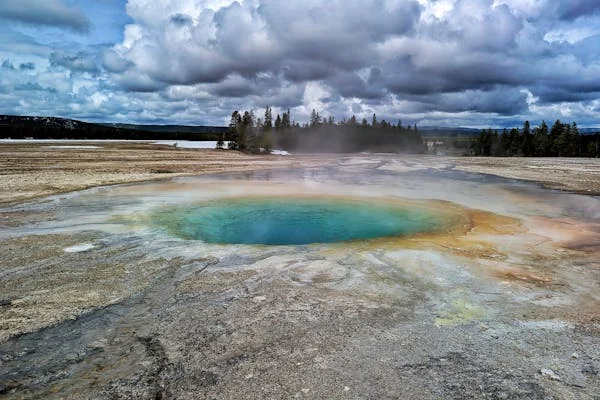Introduction
In the depths of our planet’s oceans, there exists an environment that remains largely untouched by sunlight a place where light does not penetrate, and where life has adapted in ways most people would find hard to imagine. This mysterious and unique environment is known as What Is the Meaning of Aphotic Zone in Environmental Science. In environmental science, the aphotic zone plays an essential role in the global ecosystem, yet it remains one of the most misunderstood and least explored areas of our planet. In this comprehensive guide, we will take an in-depth look at the aphotic zone: its definition, characteristics, the organisms that call it home, its role in the environment, and its importance in the broader context of ecological systems.
What is the What Is the Meaning of Aphotic Zone in Environmental Science?
The aphotic zone refers to the portion of the ocean or any body of water that lies beneath the photic zone. Where sunlight can no longer penetrate. In the aphotic zone, the absence of sunlight prevents the occurrence of photosynthesis. Which is the process by which plants convert sunlight into energy. This makes the aphotic zone a region where life forms must rely on other mechanisms for energy. This unique zone is found at varying depths, depending on the water’s clarity and the location of the body of water.
Defining the Photic and Aphotic Zones
To fully understand the aphotic zone, we first need to look at the photic zone, the region above it where sunlight is abundant. The photic zone is the uppermost layer of water, usually extending from the surface down to about 200 meters (656 feet). This is where most marine life thrives because light supports the growth of phytoplankton, which in turn sustains higher trophic levels.
Once you descend below the photic zone, light diminishes rapidly, and the water becomes dark. This is where the aphotic zone begins. It typically starts at a depth of 200 meters but can extend even deeper in some locations, sometimes reaching depths of several thousand meters in the ocean.
|
Zone |
Depth |
Characteristics |
|
Photic Zone |
0 – 200 meters |
Sunlight supports photosynthesis and abundant marine life. |
|
Aphotic Zone |
Below 200 meters |
Lack of sunlight, extreme cold, high pressure, and adapted organisms. |
|
Abyssal Zone |
4,000 meters or deeper |
Extreme pressure, frigid temperatures, and bioluminescent organisms. |
Characteristics of the What Is the Meaning of Aphotic Zone in Environmental Science
The aphotic zone is defined by the absence of light, but its characteristics go far beyond just darkness. It is an environment where very few plants can grow, and animals must adapt to survive.
1. No Light Penetration
The primary feature of the aphotic zone is the complete lack of sunlight. While the photic zone benefits from the sun’s energy, allowing photosynthetic organisms to thrive, the aphotic zone is an entirely dark world. This is why it is often referred to as the “midnight zone” in oceans, as it exists in perpetual darkness. In some of the deeper regions of the ocean, no natural light ever reaches these areas, making them isolated from the surface world.
2. Cold Temperatures
The further down you go, the colder it gets. The aphotic zone is often freezing, with temperatures ranging from 0°C to 4°C (32°F to 39°F). This cold environment makes it incredibly challenging for many species to survive, but there are organisms uniquely suited to these frigid conditions.
3. High Pressure
As you descend into the aphotic zone, the pressure increases dramatically. At the surface of the ocean, the pressure is at a level that humans can withstand. However, at deeper levels, the pressure becomes so extreme that it can crush submarines and even specialized underwater robots. This high-pressure environment requires organisms to have special adaptations to withstand the crushing force.
4. Limited Food Sources
In the aphotic zone, food is scarce. Since no sunlight reaches these depths, plants cannot grow, and photosynthesis cannot occur. As a result, organisms in the aphotic zone must rely on other food sources, such as dead organic matter that sinks down from the photic zone. This matter, often referred to as “marine snow,” consists of plankton, plant material, and animal remains.
Life in the What Is the Meaning of Aphotic Zone in Environmental Science
Despite the extreme conditions, life in the aphotic zone is both diverse and fascinating. Organisms that inhabit this zone have developed unique survival strategies to cope with the lack of light, cold temperatures, and high pressure.
Adaptations to Darkness
Many creatures in the aphotic zone have adapted to their dark environment by developing specialized features. Some have evolved to produce their own light, known as bioluminescence, which allows them to communicate, attract mates, and hunt prey.
- Bioluminescent Organisms: Bioluminescence is a common adaptation in the aphotic zone. This natural phenomenon occurs when an organism produces light through chemical reactions in its body. Many fish, squids, and microorganisms use bioluminescence for a variety of purposes, such as luring prey or camouflaging themselves in the dark waters.
Adaptations to Cold and Pressure
The aphotic zone’s extreme cold and high pressure require organisms to have specific biological adaptations that allow them to survive in these harsh conditions.
- Slow Metabolism: Many organisms in the aphotic zone have a very slow metabolism, which helps them conserve energy in an environment where food is scarce.
- Unique Body Structures: Some creatures in the aphotic zone have adapted by growing larger eyes to detect the faintest traces of light, or by evolving strange appendages to capture prey in the dark.
Example Organisms in What Is the Meaning of Aphotic Zone in Environmental Science
- Anglerfish: Known for its bioluminescent lure, the anglerfish uses light to attract prey in the darkness of the aphotic zone.
- Giant Squid: A deep-sea dweller, the giant squid uses its large eyes to detect light and prey in the darkness.
- Deep-Sea Shrimp: These shrimp feed on dead organic matter that sinks from the photic zone. They are a primary food source for many animals in the aphotic zone.
- Deep-Sea Jellyfish: With their bioluminescent capabilities, jellyfish thrive in the abyssal regions of the ocean, using their light to attract prey.
Importance of What Is the Meaning of Aphotic Zone in Environmental Science
Though the aphotic zone may seem isolated and inhospitable, it plays a crucial role in the broader marine ecosystem. The organisms that thrive here contribute to vital ecological processes, such as nutrient cycling and energy transfer.
1. Carbon Cycle and Climate Regulation
The aphotic zone is closely linked to the Earth’s carbon cycle. Organic matter that sinks from the photic zone contributes to the sequestration of carbon in the deep ocean. This process helps regulate global carbon levels and plays a role in mitigating climate change. As organic material decomposes in the aphotic zone, it forms part of a complex food web that helps maintain the balance of marine ecosystems.
2. Global Food Web
What Is the Meaning of Aphotic Zone in Environmental Science is home to a diverse array of creatures that play important roles in the oceanic food web. Despite the lack of sunlight, energy is still transferred through the system by consuming organic material that sinks from above. In turn, these organisms provide food for predators in deeper layers of the ocean, ensuring that energy continues to flow through the system.
3. Unique Biodiversity
The aphotic zone is a hub of biodiversity, with many species adapted to the extreme conditions. Some of these species are unique to the aphotic zone and are not found anywhere else on Earth. Understanding this biodiversity is important for preserving the health of marine ecosystems and for advancing scientific knowledge.
Human Impact on the Aphotic Zone
The aphotic zone is not immune to human activity. Industrial pollution, deep-sea fishing, and oil exploration are some of the human activities that impact the health of this critical environment.
1. Pollution and Waste
Pollution, including plastic waste and chemical runoff, can reach the aphotic zone, where it remains for long periods due to the lack of sunlight. This can have long-lasting impacts on the delicate ecosystems in these regions, poisoning organisms and disrupting their natural behavior.
2. Deep-Sea Exploration
Deep-sea exploration has expanded in recent years, allowing scientists to study the aphotic zone more closely. However, these explorations also bring risks, including the potential for disturbing fragile ecosystems or introducing harmful materials into these pristine environments.
3. Climate Change
As the global climate warms, the temperatures of the oceans are rising, which can lead to changes in the distribution of species and alter the conditions in the aphotic zone. Warmer waters at shallower depths may push some species deeper, altering the delicate balance of ecosystems in these regions.
Conclusion
What Is the Meaning of Aphotic Zone in Environmental Science is one of the most mysterious and fascinating environments on Earth. Despite the absence of light, it is home to a wide variety of organisms. They have evolved remarkable adaptations to survive in this harsh, cold, and high-pressure environment. As we continue to explore the depths of the ocean and learn more about this important ecological zone. It becomes increasingly clear that the aphotic zone plays a crucial role in maintaining the balance of life on our planet. Understanding the aphotic zone is not only important for scientists.
In conclusion, the aphotic zone is more than just a dark, cold abyss. It is an essential component of the global ecosystem. Home to unique and resilient life forms, and plays a pivotal role in maintaining the balance of Earth’s ecological systems. With continued research and conservation efforts, we can better understand and protect this mysterious region of our planet.





